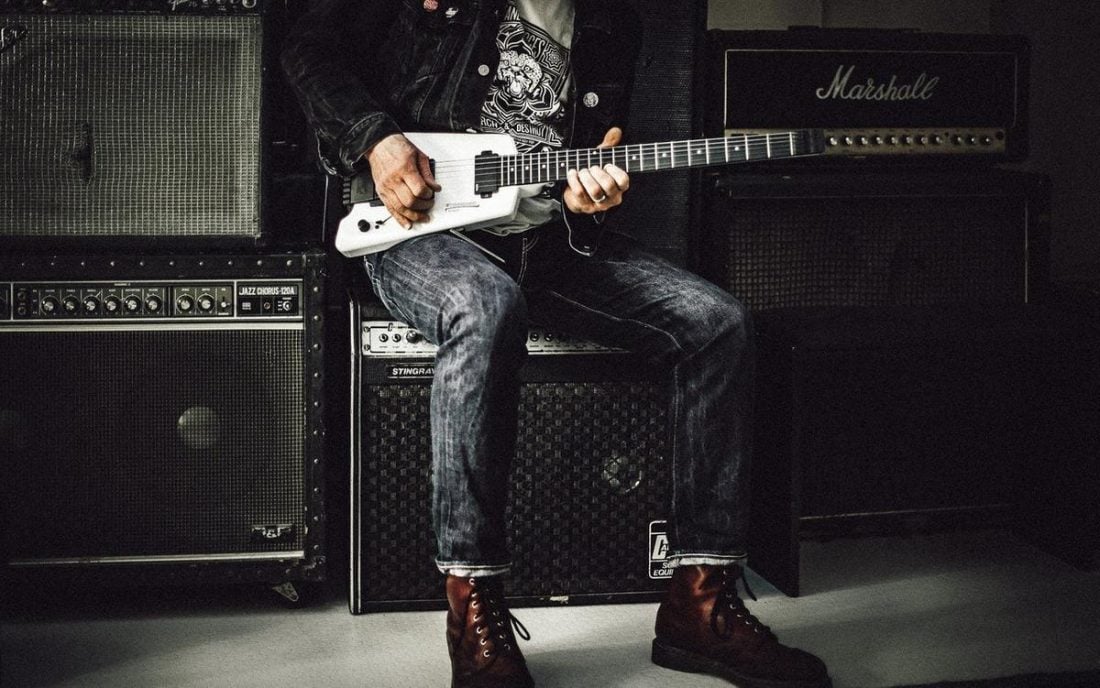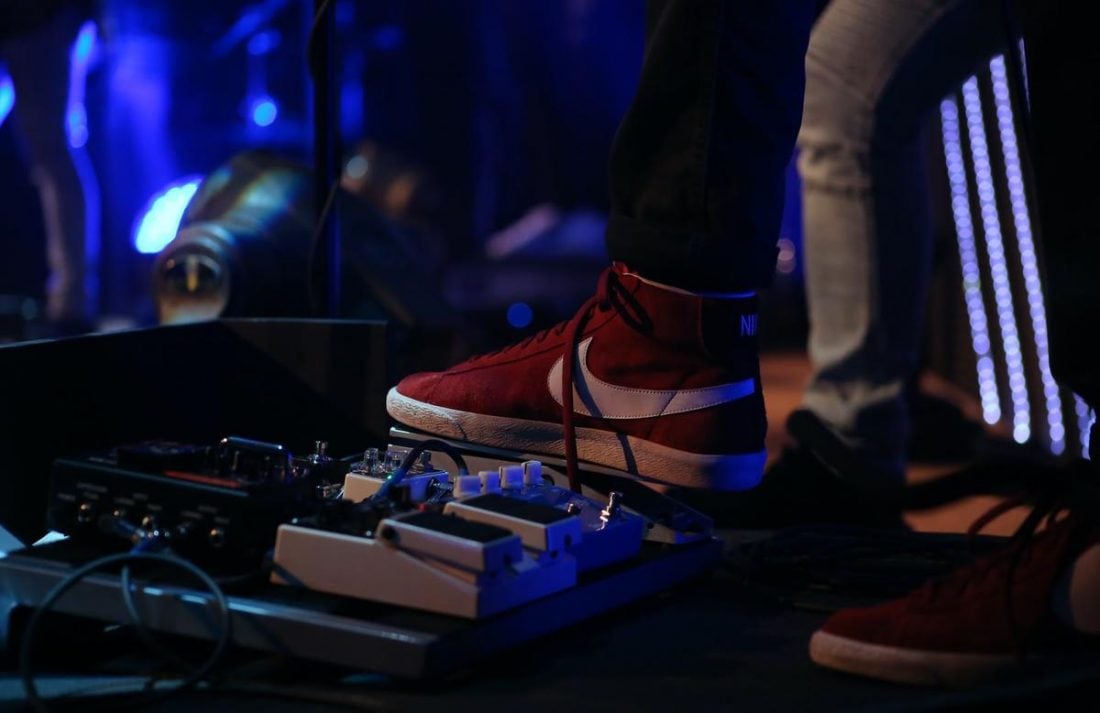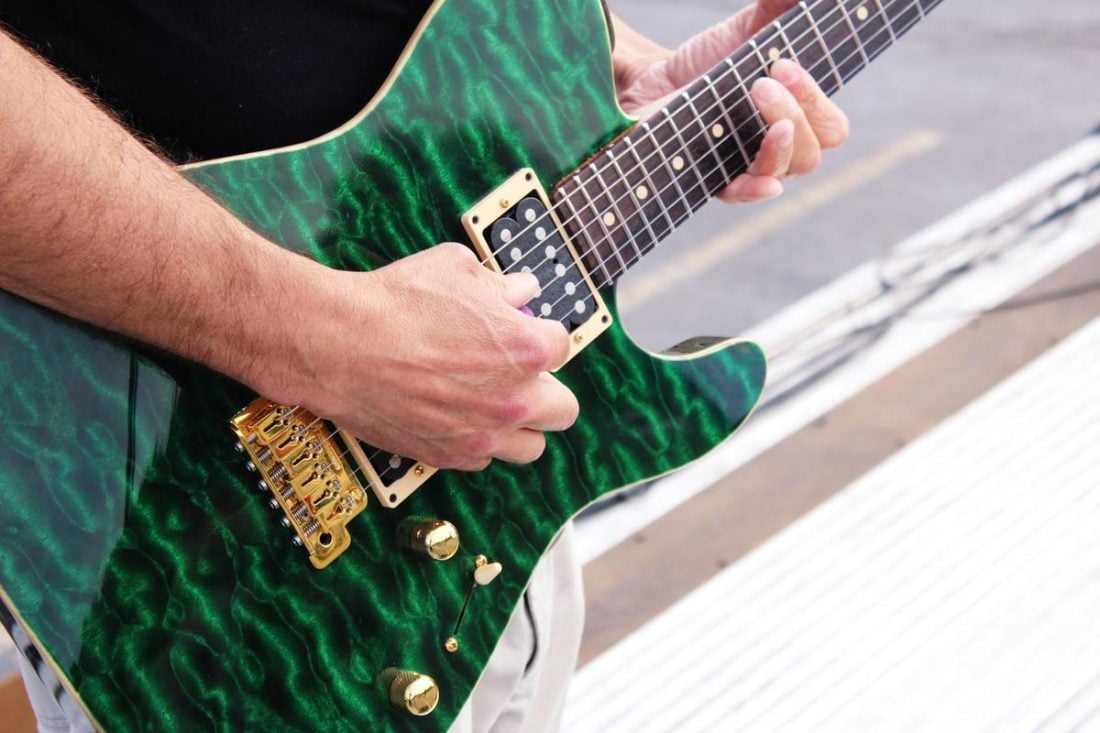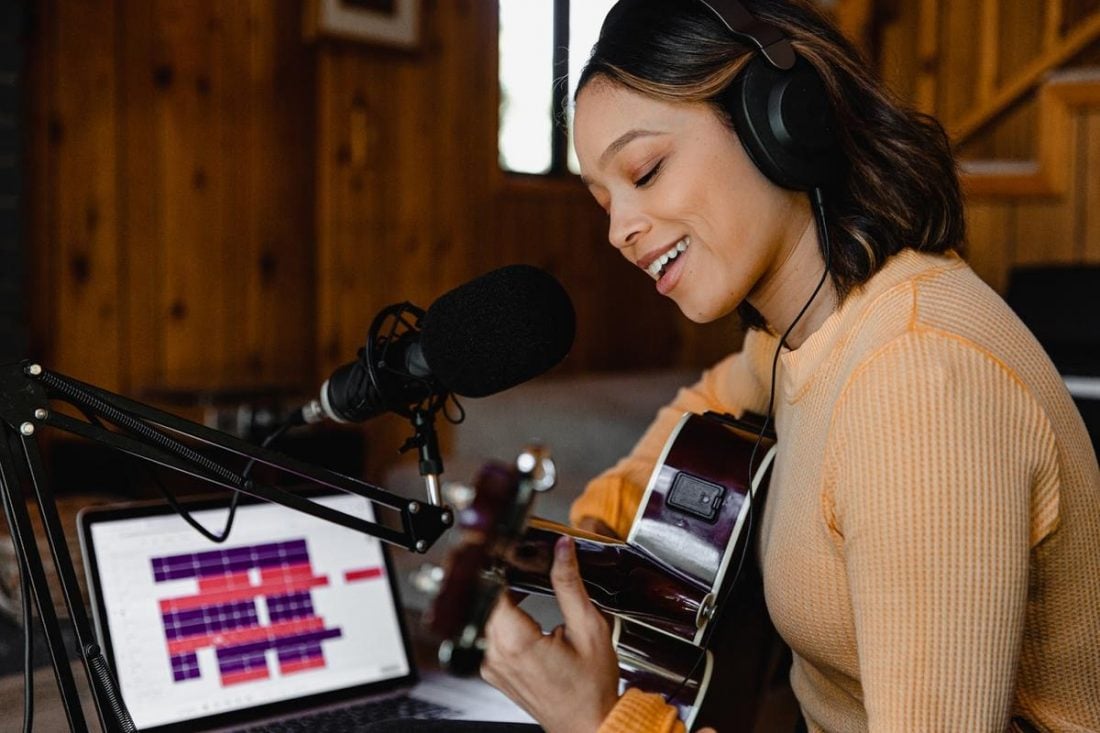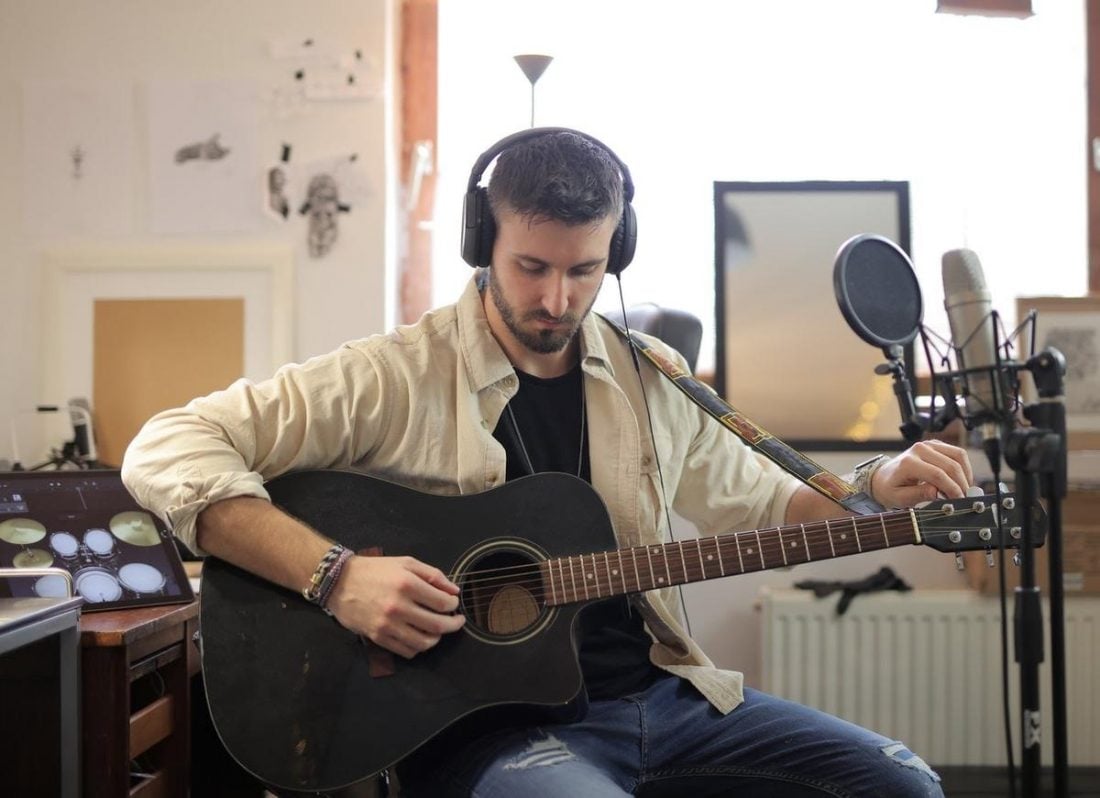When you want to practice on your electric guitar, but your spouse, housemates, or worse, irritable Mrs. Jones next door comes pounding at your door asking you to quiet down – you need to put your headphones on. It’s not just the polite thing to do, and luckily, it’s also quite easy to fix. No, you can’t just plug your headphones into your guitar. But here’s what you can do to play guitar using your headphones so you don’t have to bother everyone else.
Why Play Your Electric Guitar With Your Headphones On
Rocking out loud to a stadium full of adoring fans is the best way to play your guitar. Doing the same thing alone in an empty room isn’t quite as fun, but it still feels good when you can feel your music through the floor and walls of the room. Unfortunately, most people won’t feel the same way as you. It’s not that they hate your music. It’s just that, oftentimes, the sound of your electric guitar or even your bass guitar booming through the amplifier speakers is too loud. It keeps other people from doing their tasks. They can’t concentrate on work. The baby can’t sleep. Or your neighbor just can’t stand it. This opens up more practice time for you since you can practice any time of the day or night without waking up the whole house. You can also play anywhere you like because you no longer have to lug around a huge amplifier just to be able to play. With more practice time in, you get better at your musical craft much more quickly. You also get to listen to playback more closely, letting you pick up on subtle tones that you’d otherwise not hear if you were playing with an amp. Finally, some apps that let you connect your electric guitar to your headphones through your smartphone or computer also let you record your music and add virtual effects similar to what you get with a physical stompbox. If you choose this option, you’ll need to download and install new software into your device.
How to Use Electric Guitar With Headphones
There are many ways for you to use headphones with your electric guitar. These include:
Plug Your Headphones Into an Amplifier
The fastest, easiest way to play the guitar with your headphones is to plug them into an amplifier. And, if you already have one, there’s no additional expense needed. The amp will convert the signal from your guitar and provide plenty of power so you can hear the sound through your headphones. Many modern amps have outputs for 3.5-mm headphones, but a lot of units have the larger 6.35-mm jacks similar to the size of an electric guitar plug. If your amp has the latter, you’ll need to get a 6.35-mm to 3.5-mm adapter to get the job done.
Use a Multi-Effects Pedal
A multi-effects pedal takes your audio input (i.e. the sound from the electric guitar) and modifies it according to your preferences so that the output features an “amp-like tone”. Almost every modern multi-effects pedal you’d find on the market has an output for headphones, which is usually labeled the “line out” output. If it has some type of amp modeling, you can almost always plug in your headphones. Sometimes, the output is called “phones” or simply “headphones”. If you haven’t bought yourself a multi-effects pedal yet, now may be the right time to get one. The best ones include:
Line 6 HX Stomp – This compact pedal is small enough to fit into your bag’s back pocket so you can play your electric guitar anywhere.
It comes with more than 300 amps, cabinets, and effects and lets you use up to six of them at the same time. It also doubles as a USB-powered audio interface, which lets you record music with your smartphone or computer.
Orange Terror Stomp – Another pocket-sized, portable unit that’s great for getting the show on the road, the Terror Stomp from orange packs in 20 watts of power in a little box.
It includes a buffered FX Loop to ensure top-quality sound and a CabSlim headphones output for practicing solo.
Connect Your Guitar to a Micro-Amp
These tiny amps are so small they can fit inside the back pocket of your gig bag so you can take them with you anywhere. Most of the time, you simply need to plug the micro-amp into your guitar and start playing. A lot of micro-amps have a 3.5-mm output designed specifically for headphones or speakers. It’s a great option for practice sessions because of the minimal setup required and the ability to use it with headphones. If you’re looking for a high-quality micro-amp, we recommend:
VOX amPlug 2 – This ultra-compact, ultra-lightweight amp is a simple plug-and-play solution if you need to use headphones with your electric guitar right away.
Simply insert the headphone plug into the 3.5-mm output and you’re good to go. It runs on three AAA batteries and can rotate a full 180 degrees so you can position it more conveniently. This micro-amp comes in various models, depending on your genre. Whether you love classic rock, metal, bass, clean, or blues, there’s a VOX amPlug 2 for that.
Use an Audio Interface to Connect With a Computer or Phone
An audio interface lets you record music directly with your computer or smartphone. You connect it to your guitar through one cable and to your computer or smartphone through another cable and then play. The analog signal that comes from your electric guitar gets sent to the interface’s mic preamplifier where it turns to a line-level signal. This is then passed to the analog-to-digital converter where the signal turns into a string of 1s and 0s that the computer can recognize. The signal now travels to the computer via a Digital Audio Workstation (DAW)—that’s the software used for recording, editing, and producing sound files. The DAW interprets the signal and adds effects if you want it to and then sends it to the digital-to-analog converter so you can hear the playback through the headphones output. The process may seem long and complicated, but everything happens in less than a fraction of a second so that you hear the sound at the same time as you’re making it. If you choose this option, you’ll be getting far more out of an interface than simply being able to play the electric guitar with headphones. You also get to record, process, and produce music with it.
Audio interfaces for Mac or PC
Some of the best audio interfaces for your computer include:
Focusrite Scarlett Solo – Easily the bestselling interface in the market, and for good reason. This compact interface lets you capture studio-quality sound without needing to own or even rent a studio.
Use the Easy Start quick setup guide so you can record and playback within minutes. The Scarlett Solo comes with hundreds of virtual instruments and 500MB of loops and sound effects. It works with a variety of DAWs, including GarageBand, Cubasis 2, Auria Pro, and many others.
Behriner UM2 – This is a simple and straightforward interface that you can plug and play straight away. It has a studio-grade mic preamp and line level input for vocals and direct instruments.
It also has a clearly labeled “phones” output for your headphones and an extra 6.35-mm output for speakers or other instruments. If you’re using a computer, here are the best DAWs to use:
AmpliTube Custom Shop – The Custom Shop prides itself for being a one-stop shop for growing your gear collection. You can demo any gear you want for a whole 72 hours and after that decide from there if you want to pay for it or not.
This is a standalone app available for both Mac and PC. It’s free and comes with 24 gear pieces for you to start with, including stompboxes, amp heads, and cabinets.
NA Guitar Rig 5 Player – This powerful virtual effects processor is easy and intuitive to use. It comes with a British-style tube amp with a matched cabinet, 13 effects, and a bundle of 2,000 sounds.
It’s the free version of Guitar Rig 5 Pro. If you get the latter, you also receive 54 effects, including stompboxes and rackmount processors, 17 cabinets, and 13 effects all for free.
Amped Roots – This free amp simulation app gives you access to simulations used in Ryan “Fluff” Bruce’s collection. It includes one free amp, with access to three more if you buy the full license.
Audio interfaces for iOS and Android
You can also use your iPhone or Android phone to play the guitar using headphones through an interface made for smartphones. For iPhone users, you can rely on:
iRig 2 – This is specifically designed for Apple devices, including the Mac, iPhone, and iPad. It has a 3.5-mm output that you can use to plug your headphones or a guitar or bass that has a similar plug.
The iRig 2 connects to a variety of DAWs. If you’re using an iPhone or iPad, the best DAWs are:
GarageBand – Apple’s own sound editing app is a richly-featured recording studio that lets you record music with up to 32 tracks.
You can play keyboards, guitars, and download additional instrument sounds, loops, and effects for free into your Sound Library. GarageBand is free for Mac and iOS devices.
JamUp – Positive Grid’s Jam Up is a multi-effects processor for guitar and bass that gives you access to ToneCloud, a huge community of guitar enthusiasts who have pooled more than 10,000 presets that you can download and use for free.
JamUp comes with one amp and six effects. If you buy a pro license, you can get another six amps and 16 rack and stompbox effects. Expansion packs are also available if you want more amps and effects.
BIAS Amp 2 – The app’s intuitive design lets you use the app right away without having to figure out where things are. You get 36 modern, vintage, and specialist rock amps and access to Positive Grid’s ToneCloud community. BIAS Amp 2 also links with Apple’s GarageBand.
If you have an Android, the best interface you can get is:
iRig UA – This multi-effects interface and processor runs on any device with Android Jelly Bean or higher, although you need to have at least Android Lollipop if you want to use it to record music.
It works with AmpliTube UA and includes a headphones output for listening to playback. The iRig UA doesn’t need batteries to operate. It runs off the power of any device you plug it into. Still have a few questions? Here are our answers to the most commonly asked questions that people have when attempting to connect their headphones with their electric guitar, including:
Can I connect an electric guitar to Bluetooth headphones?
There aren’t many options for this because Bluetooth headphones have yet to get around issues of latency. There’s often a length of time between the time the music is played and the time it’s played back through the headphones. In some cases, the delay isn’t noticeable. But in other cases, it is and it creates an annoying delay between the time you pluck the string and the time you hear the sound the string makes. The closest you can get to using Bluetooth headphones with an electric guitar is the Boss Waza-Air headphones. These look like headphones but they can do more than regular headphones do. They use an accompanying wireless receiver to receive signal from your guitar, mimicking the sound of an amplifier in the room. The Waza-Air uses augmented reality to track the movements of your head and use that data to change the sound of a virtual amp so that it sounds like you’re hearing the playback from a real amp. It comes with five amps and 50 effects that you can control through its Android or iPhone app. It also has low-latency tech so you can keep playing without being bothered by latency issues.
Can I plug my headphones into my electric guitar?
No, you’ll get no sound coming through if you do. That’s because the signal from your electric guitar isn’t powerful enough. It needs to be amplified to be heard. That’s what amplifiers are for. They turn a small electric signal and convert it into something that the human ear can hear. Amplifiers boost the signal from your guitar. An audio interface can also do the same.
Do guitar amps have headphone jacks?
Yes, most modern amps have headphone jacks. However, some amps have a 6.35-mm output that won’t match the usual 3.5-mm plug that most headphones have. If that’s the case with your amp, you need a 6.35-mm to 3.5-mm adapter to get it to work.
Conclusion
Wouldn’t it be awesome to be able to keep jamming on your electric guitar all throughout the night, with your baby sleeping and your spouse peacefully reading just two feet away from you? A pair of headphones can do that for you. Were you able to use your headphones with your guitar? What method worked for you? Let us know in the comments below.
